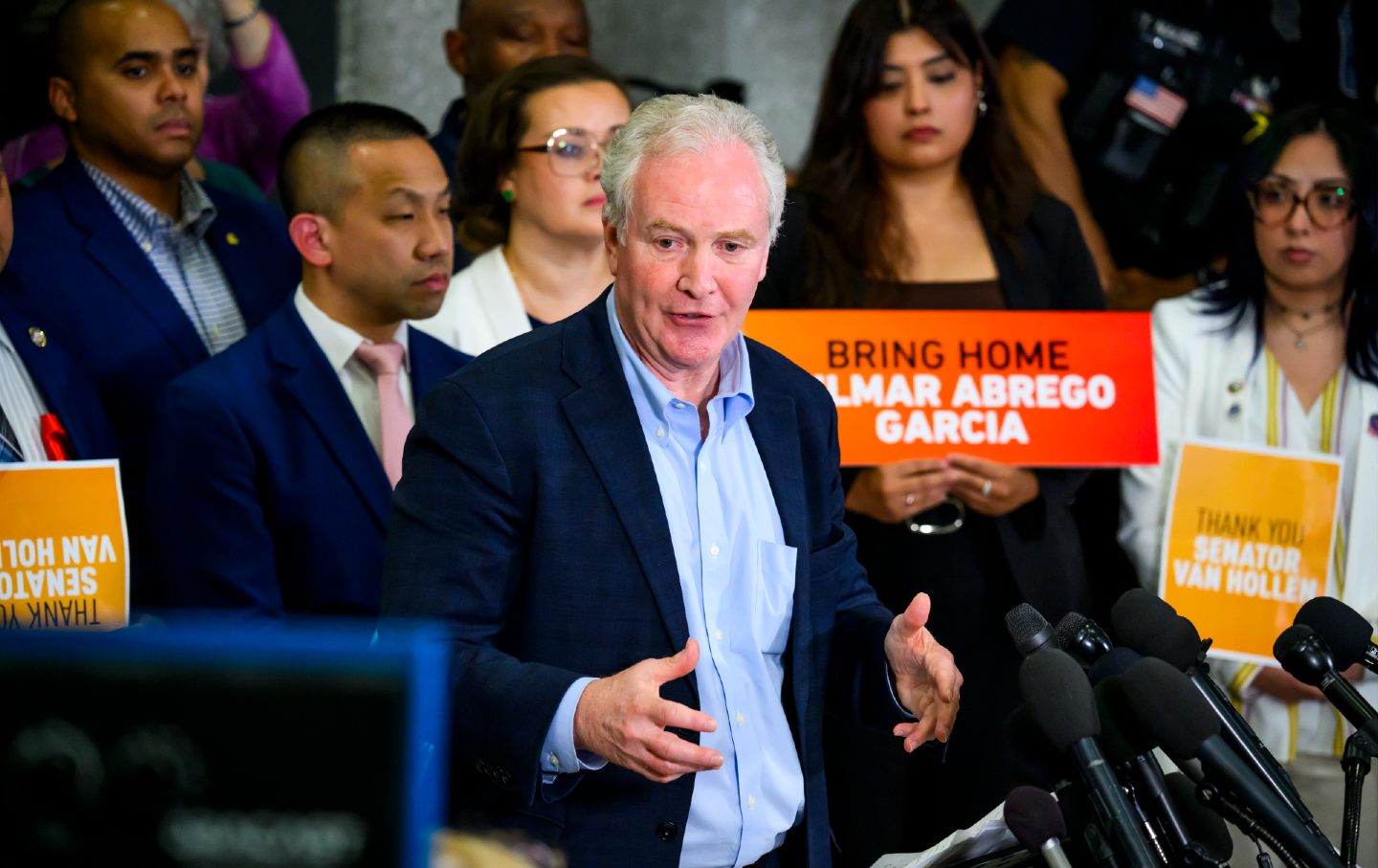Here in Iowa, the Fight Goes On
In Johnson County, a record-breaking 87,012 people voted on Tuesday. Democrat Christina Bohannan beat the Republican incumbent by over 35,000 votes—just 800 shy of what she needed.

Iowa City, Iowa—“I can’t quit door-knocking until I have the ultimate experience of a naked person coming to the door.”
Organizer Sharon Lake is half-serious as she trains and inspires 15 Democratic volunteers for door-to-door canvassing. At the end of her 20-minute presentation, the volunteers—mostly middle-aged women who have never door-knocked before—charge out of Johnson County Sheriff Brad Kunkel’s garage, clipboards and campaign lit clutched in their hands.
Lake might be joking during training (“So far I’ve only had loosely draped towels”), but she is 100 percent serious about grassroots organizing. Starting as an Obama precinct captain in the 2008 Iowa caucuses, she now trains Democratic volunteers across eastern Iowa.
Iowa caucus organizing was strong 16 years ago, but an effective statewide structure didn’t exist. Volunteers were deployed without adequate training, and systematic canvassing didn’t begin until late summer or fall before elections. Lake, now retired from her job as a supply chain manager for a natural food producer, began to build a team and develop a strategy focused on training (“no meetings, just training and working”) and starting early. This last election cycle, Lake’s team started one year ago and extended its reach to Scott County, an hour’s drive away.
Dan Feltes, an Iowa native who had become the youngest majority leader in the history of the New Hampshire Senate, moved his family back to Iowa City a couple of years ago and quickly became involved in local politics. He helped develop the early door-knocking plan, with an initial emphasis on listening to voters’ concerns rather than campaigning for specific candidates. When it came time for persuasion and turnout efforts, thousands of voters had already been “touched” by a friendly neighbor who wanted to know what issues were important to them.
The army of canvassers recruited and trained by Lake was a major factor in the record-breaking plurality of votes in the latest congressional race in Iowa’s southeast quadrant. As many as 100 volunteers showed up daily in Iowa City alone. Many of them drove to other towns in their congressional district (Iowa’s 1st). State Senators Adam Zabner and Janice Weiner estimated that between them they hit upwards of 4,000 doors in 10 counties (Weiner was often accompanied by Alaska, her 6-year-old granddaughter). Feltes reported that volunteers knocked on approximately 58,000 doors.
The results of this fine-tuned ground game were astronomical in Johnson County, home of the University of Iowa and a longtime Democratic stronghold: 87,012 people voted—the biggest turnout in the county’s history. Democratic candidate Christina Bohannan received a record-breaking 35,225 more votes than Republican incumbent Marianette Miller-Meeks here. That margin is the second-largest for a federal office in county history, ahead of Senator Tom Harkin’s landslide reelection in 2008, and only behind President Biden’s election in 2020. Even though Trump increased his numbers in Iowa, Bohannan’s margin (and Kamala Harris’s) exceeded even Obama’s when he twice won Iowa. Sadly, her record-breaking plurality in Johnson County was still not enough to topple Miller-Meeks, who won this deepest red district made up of 20 counties by just 799 out of 412,000 votes cast.

Bohannan won only two other counties in the 20-county district. Scott County, part of the once-Democratic Quad Cities, gave her a 1,998-vote plurality. Jefferson, home of Maharishi University transcendental meditators, gave her 227 more votes than Miller-Meeks. That was it—three counties out of 20. The strategy crafted by Lake, Feltes, and Bohannan’s staff to break the bank in “the People’s Republic of Johnson County” (and cut into Republican margins in the other counties) was a sound one. It almost worked, but just wasn’t quite enough to overcome a Republican landslide in a district that, like the rest of Iowa, has turned redder and redder in the last decade.
Where do Iowa Democrats go from here? Many of the soldiers in the army of door-knockers were motivated by Republican Governor Kim Reynolds’d cheerleading for the state’s ban on abortion after six weeks. It was not unusual to see a preponderance of older women charging into the streets after a Sharon Lake training session. The question now is whether enough future voters will connect the dots between Trump, his US Supreme Court appointments, Governor Reynolds, the Republican legislature, and the Iowa Supreme Court judges appointed by Reynolds who ruled that the six-week ban is constitutional.
John Norris, administrator for Polk County (Iowa’s largest) and a former gubernatorial candidate, agrees that the abortion ban and an extraordinary ground game will continue to be crucial if Democrats are to recover from their latest shellacking. Norris also cited an unsustainable budget due to massive Republican tax cuts, and continuing attacks on funding for public education, as more dots for people to connect.
Despite the heartbreak of this election, one thing is certain: Sharon Lake will still be canvassing during the next cycle, still hoping for a naked person to come to the door.
Hold the powerful to account by supporting The Nation
The chaos and cruelty of the Trump administration reaches new lows each week.
Trump’s catastrophic “Liberation Day” has wreaked havoc on the world economy and set up yet another constitutional crisis at home. Plainclothes officers continue to abduct university students off the streets. So-called “enemy aliens” are flown abroad to a mega prison against the orders of the courts. And Signalgate promises to be the first of many incompetence scandals that expose the brutal violence at the core of the American empire.
At a time when elite universities, powerful law firms, and influential media outlets are capitulating to Trump’s intimidation, The Nation is more determined than ever before to hold the powerful to account.
In just the last month, we’ve published reporting on how Trump outsources his mass deportation agenda to other countries, exposed the administration’s appeal to obscure laws to carry out its repressive agenda, and amplified the voices of brave student activists targeted by universities.
We also continue to tell the stories of those who fight back against Trump and Musk, whether on the streets in growing protest movements, in town halls across the country, or in critical state elections—like Wisconsin’s recent state Supreme Court race—that provide a model for resisting Trumpism and prove that Musk can’t buy our democracy.
This is the journalism that matters in 2025. But we can’t do this without you. As a reader-supported publication, we rely on the support of generous donors. Please, help make our essential independent journalism possible with a donation today.
In solidarity,
The Editors
The Nation








